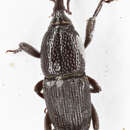en
names in breadcrumbs


Brown, more or less dark, 3-5 mm long, elongated anddepressed in the lower part. Pronotum almost as long as elytra. Hind wings lack.
The species has a worldwide distribution (cosmopolitan), particularly in temperate zones and cold climates. Attacks all cereal grains (eg: wheat, corn, oats, maize, barley, sorghum) as well as many other seeds and processed cereal products. Adults live preferably in the inner layers of the grain mass, in dark or low light conditions.
They mate in spring and after a few days the female starts oviposition. Each female lays only one egg (with rare exceptions) to caryopsis, by drilling a hole with the rostrumand introducing the abdomen end. Subsequently the female mixed with saliva the sawdust produced and closes thehole with it.
A female may lay 2-3 eggs a day, for a total of about 350, in a period of 8-9 months. After several days (4 to 15), according to the environmental temperature, the egg hatches andthe larva feeds in the caryopsis, without never going out. The larvae mature in 20-40 days and pupate within the kernel; pupal development lasts 5-20 days, followed by a period of a few days in whichthe fully differentiated adult stay in the cell.
The adult then opens a gap in the seed coat of the kernel through buccal apparatus. During the year, from June, you may experience continuous flicker of adults and an overlap of generations. In the same population, part of individuals can perform post-embryonic development in a time almost two times longer than that required by other individuals. In temperate climates, the species has 3-6 generations per year. Wintering usually occurs as an adult.
The wheat weevil (Sitophilus granarius), also known as the grain weevil or granary weevil, is an insect that feeds on cereal grains, and is a common pest in many places. It can cause significant damage to harvested stored grains and may drastically decrease crop yields. The females lay many eggs and the larvae eat the inside of the grain kernels.
Adult wheat weevils are about 3–5 mm (0.12–0.20 in) long with elongated snouts and chewing mouth parts.[2] Depending on the grain kernels, the size of the weevil varies. In small grains, such as millet or grain sorghum, they are small in size, but are larger in maize (corn).[3] The adults are a reddish-brown color and lack distinguishing marks. Adult wheat weevils are not capable of flight. Larvae are legless, humpbacked, and are white with a tan head. Weevils in the pupal stage have snouts like the adults.
Female wheat weevils lay between 36 and 254 eggs and usually one egg is deposited in each grain kernel. All larval stages and the pupal stage occur within the grain. The larvae feed inside the grain until pupation, after which they bore a hole out of the grain and emerge. They are rarely seen outside of the grain kernel. The life cycle takes about five weeks in the summer, but may take up to 20 weeks in cooler temperatures.[4] Adults can live up to eight months after emerging.
Adult wheat weevils when threatened or disturbed will pull their legs close to their bodies and feign death. Female weevils can tell if a grain kernel has had an egg laid in it by another weevil.[5] They avoid laying another egg in this grain. Females chew a hole, deposit an egg, and seal the hole with a gelatinous secretion. This may be how other females know the grain has an egg in it already. This ensures the young will survive and produce another generation. One pair of weevils may produce up to 6,000 offspring per year.
It is not found "in the wild", but only in human food-storage situations.[6]
Wheat weevils are wheat, oats, rye, barley, rice and corn pests. Unfortunately the impact of wheat weevils worldwide is unknown because information is not well shared. It is believed to be especially bad in places where the grain harvests are not accurately measured. The weevils are hard to detect and usually all of the grain in an infested storage facility must be destroyed. Many methods have been attempted to get rid of the wheat weevil, such as pesticides, different methods of masking the odor of the grain with unpleasant scents, and some have even gone as far as introducing predator organisms.[7]
Sanitation and inspection are key to preventing infestation. Grains should be stored in preferably metallic (cardboard, even fortified, is easily drilled through by the weevil) containers with tight lids in a refrigerator or a freezer, and should be purchased in small quantities. If any suspicion has arisen, carefully examine the grains for adult insects or holes in the grain kernels. Another method is to immerse them in water. If they float to the surface, it is a good indication of infestation. Even if identified early, disposal may be the only effective solution.
The wheat weevil (Sitophilus granarius), also known as the grain weevil or granary weevil, is an insect that feeds on cereal grains, and is a common pest in many places. It can cause significant damage to harvested stored grains and may drastically decrease crop yields. The females lay many eggs and the larvae eat the inside of the grain kernels.